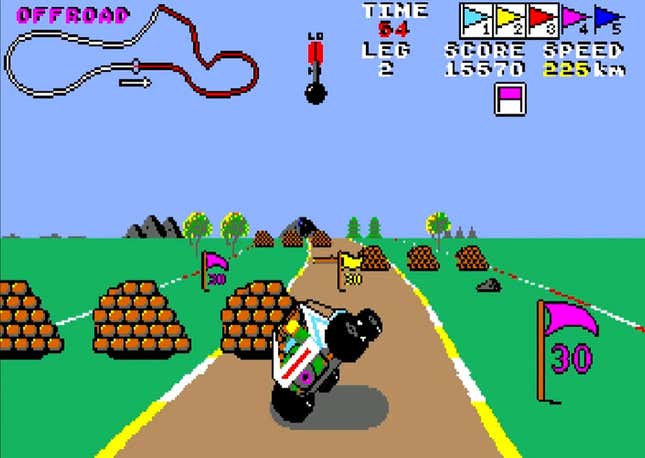Mario Kart World Triggers Memories Of A Forgotten 80s Classic
I spent an enormously disproportionate amount of my childhood playing one game: Buggy Boy. I have learned, in preparation for this article, that this arcade classic had a different name in the U.S. “Speed Buggy.” Pah-tooie. Ew. No. It’s Buggy Boy, and it was—until 2025—the only racing game that recognized the vital importance of driving a car on two wheels. Now that Mario Kart World has revived this core conceit, it’s time to give Tatsumi Electronics’ all-time classic the recognition it deserves.
Honestly, what is it with you Americans and your determination to choose a completely rubbish version of something the rest of the world does differently? The imperial system? Fahrenheit? Putting your dates in an entirely random order? And Speed Buggy?! No. It was Bagī Bōi (バギーボーイ) in Japan, and that just flat-out translates to Buggy Boy. Speed Buggy was a 1973 crossover cartoon with Josie and the Pussycats for Hanna-Barbera. The matter is resolved. I accept your apology.
Buggy Boy was first released as an arcade game in Japan in 1985, including in a cockpit cabinet with a three-screen display. Come 1987 it was ported across to the Commodore 64 and Amstrad CPC, before being realized in its perfect version in 1988 for the ZX Spectrum, Amiga and Atari ST. It was then that a 10-year-old John Walker played that game until the digital tyres (yes, tyres—“tires” means to get sleepy) wore thin.
Because my dad was flawed, we had an Atari ST instead of an Amiga, and as such were left with all the crappy gaming magazines and the desperate, unconvincing cry of “But it’s used by professional music producers!” But at least I also had Buggy Boy, the first game to understand that all vehicular racing is improved when tipped on one side.
Buggy Boy was, as you might suspect from the year it was released, a relatively simple racing game—relative to today. At the time, it was positively intricate, primarily because of the clutter on the roads. Rather than your generic racetrack of games like Pole Position, empty save for the presence of other cars, on the mean non-streets of BB you were faced with all manner of obstacles, from logs and rocks to barriers and piles of bricks. At the same time, the five different tracks were covered in flags to drive into and banners to drive under, to score extra points, and—most importantly—means by which you could cause your car to both jump and flip up on its side onto two wheels.
It’s so important to remember that this is a full seven years before Super Mario Kart would appear on SNES, and while Buggy Boy was a single-player game with a single car on the tracks, I find it impossible not to trace a lineage. The madcap nature of Mario’s courses, while certainly born of F-Zero, still feel somewhat inspired by Buggy Boy to me. And yet I never hear a soul mention this game, ever.
Just the ability to jump, I think, marks out BB as special. Cars—and stay with me here—cannot jump. They can be launched, certainly, but their ability to hop up into the air by means of driving over a log has yet to be recorded in nature. It’s a gloriously silly feature that too many racing games would have eschewed, in favor of “realism.” But nothing was better than when you drove over a slanty small rock in the road and tipped up on two wheels.

The game knew it. You scored way more points when you drove like this, and it didn’t slow you down. The effect lasted until you hit any other obstacle or feature, and as your buggy plopped down onto four wheels once more, your heart sank with it, a new high score likely missed.
Playing Mario Kart World—a game I’m honestly struggling to love (despite playing as a Cheep Cheep)—every time I find myself grinding a railing, fence or barrier, seeing my kart tip up diagonally, I just feel a nostalgic hit of delight. This! This is what’s been missing from racing games for nearly 40 years! It makes me happy, the way hearing a long-forgotten song you loved in your teenage years can wrap you in the emotions of memory.
There was so much more to it, too! You had to collect the colored flags in the order shown on screen, for bonuses, and the time gates were vital to ensure you could keep playing (complete with the on-screen symbols that I always parsed as Monopoly cards). Then there was the range of track offerings: an offroad track you’d loop around five times, as well as four other unique courses each made up of five distinct stages. It had that Mario Kart-like map to keep you focused, and have I mentioned how much I love going up on two wheels?
Buggy Boy has never received the love and recognition it deserves. Where are the modern remakes? The arcade classic celebrations? The misguided attempt to reboot the franchise as a first-person shooter? Let this be the game’s clarion call.
.














Post Comment